Core responsibilities
Statistical Information
Description
Statistics Canada produces objective, high-quality statistical data for the whole of Canada. The statistical information produced relates to the commercial, industrial, financial, social, economic, environmental and general activities and conditions of the people of Canada.
Results
Canadians still count on trusted data and reliable insights, delivered in an accessible and modern way. Statistics Canada continued to provide relevant, timely and high-quality data that informed sound research, analysis and policies to benefit Canadians.
To keep meeting the need for high-quality data, the agency's multi-year modernization journey and its results are built on five guiding principles:
- providing user-centric services
- using leading-edge methods of data collection and integration
- building statistical capacity and fostering data literacy
- collaborating and engaging with partners
- building an agile workforce and workplace.
 Providing user-centric services
Providing user-centric services
Canadians value high-quality, efficient and responsive user-centric services, especially since the beginning of the COVID-19 pandemic. With increasing economic uncertainty, they seek data at the community and business levels. To ensure that Canadians have information when and how they need it, Statistics Canada has developed innovative ways to make data more inclusive and easier to access, share and use by
- disseminating results from the 2021 Census—a rich source of population data
- releasing data from the Census of Agriculture
- producing more disaggregated data for a fairer, more inclusive Canada
- developing better data for better outcomes
- producing business data to address lingering economic uncertainties
- further integrating social and business data
- meeting the evolving data needs of official language minority populations
- connecting with Canadians in a digital world
- building and maintaining public trust and understanding
- accelerating research through increased microdata access.
Disseminating results from the 2021 Census: A rich source of population data
- The 2021 Census provided the Government of Canada and all Canadians with a wealth of high-quality information, new and more granular data, products, and new metadata content. Over the past year, Statistics Canada proudly published seven themed major releases of 2021 Census data, with over 350 data tables and 30 analytical products, as well as visualization tools and infographics covering 18 major topics. This gave Canadians access to 31 billion data points—an unparalleled level of detail and insight.
- The agency provided federal briefings, media technical briefings, webinars and press conferences for each release and coordinated more than 150 media interviews. Five releases were covered live on national networks, social media campaigns reached 12.4 million impressions and 311,000 engagements, and more than 50,000 organizations and stakeholders were contacted through email campaigns for the various releases.
- The seven major census releases in 2022 were
- population and dwelling counts (February)
- age, sex at birth and gender; and type of dwelling (April)
- families, households and marital status; Canadian military experience; and income (July)
- language (August)
- Indigenous peoples, and housing (September)
- immigration, place of birth and citizenship; ethnocultural and religious diversity; and mobility and migration (October)
- education, labour, language of work, commuting, and instruction in the minority official language (November).
-
As of March 31, 2023, 1,801 custom census tables had been produced, a significantly higher number than the previous census cycle in 2017–18, in which 1,221 tables were produced. It is projected that 57,471,749,909 data cells will be released from the 2021 Census, compared with 27,596,576,636 for the 2016 Census. This means the agency released more data than ever before, allowing more details to be made available to Canadians and organizations for their future planning needs.
In April 2022, Statistics Canada's Census Communications team was recognized at the Government of Canada Communications Awards of Excellence for its outstanding work on the 2021 Census. The team received the Diamond Award of Communications Excellence.
- The range of topics and granularity of the 2021 Census of Population also went further than ever before. For the first time, the census collected data on gender, making Canada the first country in the world to disseminate census data on transgender and non-binary people. The 2021 Census also provided the first census profile of Canada's military in half a century and new data on children eligible for instruction in the minority official language at the primary and secondary levels.
Releasing data from the Census of Agriculture

Description - 2021 Census of Agriculture data
The 2021 Census of Agriculture counted 189,874 farms, 262,455 farm operators and 242,052 paid employees.
Source: Statistics Canada, Census of Agriculture 2021; Area, production and farm gate valye of marketed fruits, 2021; and Area, production and farm values of potatoes, 2021.
- The 2021 Census of Agriculture included new ways to access and visualize data, such as a new mapping tool. It also included new community profiles and a variety of data tables, analytical products and reference materials on the characteristics of Canada's agriculture industry. In 2022, Statistics Canada released multiple products associated with the 2021 Census of Agriculture that were well received by Canadians, including
- Common Output Data Repository tables
- special tabulations
- new dissemination tools
- multiple analytical reports in Canadian Agriculture at a Glance.
- The Census of Agriculture also resulted in a new partnership with the Canadian Agri-Food Policy Institute related to how the results align with major trends in the agriculture industry, to gain a better understanding of the industry.
- For the first time, the 2021 and 2016 microdata were also made available in the Statistics Canada research data centres; this was beneficial to key researchers and partners.
Producing more disaggregated data for a fairer, more inclusive Canada
"Statistics Canada will continue implementing its Disaggregated Data Action Plan and integrating the richness of 2021 Census data into more of its programs."
Anil Arora
Chief Statistician of Canada
- Statistics Canada continued to develop rigorous disaggregated research and analysis to enable Canadians to deepen their understanding of equity, diversity and the inclusion of various groups. The agency used a variety of dissemination products, including flagship publications, infographics and the Research to Insights series, to communicate findings to Canadians.
- Statistics Canada's work on the DDAP continued to help critically examine the experiences of various population groups, with a focus on the four employment equity groups: Indigenous people, women, racialized populations and people with disabilities. As a driver of change, the agency's work on the DDAP helped Canada develop policies and promote evidence-based decision making, accounting for the experiences of diverse population groups in Canada.
-
The Gender, Diversity and Inclusion Statistics Hub released several high-quality research and analytical products, to increase knowledge and report to Canadians on the state and progress of gender equality and the experiences and outcomes of various groups of people in Canada. It also facilitated access to disaggregated data, intersectional analysis and insights on diverse population groups. The updated hub includes features such as a data visualization tool. It also makes new releases easier to access for all Canadians, increases engagement and allows users to see data in a more dynamic way.

- As part of Canada's Anti-Racism Strategy, Statistics Canada created a new Social Inclusion portal to bring together key statistical information on the inclusion (or exclusion) of ethnocultural groups and immigrants in Canada. The agency also launched a new series of data visualization tools, and over 120 social inclusion indicators were presented for racialized groups in Canada, disaggregated by key sociodemographic characteristics and level of geography.
- The agency created the DDAP Administrative Data Fund to give external partners the opportunity to make changes that, in turn, will provide the agency with enhanced administrative data. This will help optimize the implementation of the DDAP and leverage existing data by making them available in a clearer and more accessible way to Canadians.
- Statistics Canada published an analysis of disaggregated data in Insights on Canadian Society. Its goal was to build understanding and awareness of persistent socioeconomic inequalities in various vulnerable groups and to examine how outcomes vary by racialized population, gender, disability status and Indigenous identity, including intersections of these identities.
-
Statistics Canada also successfully completed data collection for the Indigenous Peoples Survey. Data scheduled for release in August 2024 will provide rich information and fill data gaps for First Nations people living off reserve, Métis and Inuit. The survey will provide detailed information on several topics, including education, employment, health, access to services, language, housing and mobility.

Description - 2022 Indigenous Peoples Survey
2022 Indigenous Peoples Survey
If you have been selected, please participate.
Themes covered in this survey
- Child care and services
- Indigenous languages and cultural activities
- Mental and physical health
- Education
- Skills, training and relevant experience
- Interest in government employment
- The agency also successfully delivered on nine cost-recovery Indigenous research projects with federal partners and released statistics on Indigenous peoples from the 2021 Census.
- With the completion of the 2022 Canadian Survey on Disability, Statistics Canada met its commitment to collect information from youth and adults in Canada whose everyday activities are limited because of a long-term condition or health-related problem. The data will be used to plan and evaluate services, programs and policies for Canadians living with disabilities to help enable their full participation in society.
Developing better data for better outcomes
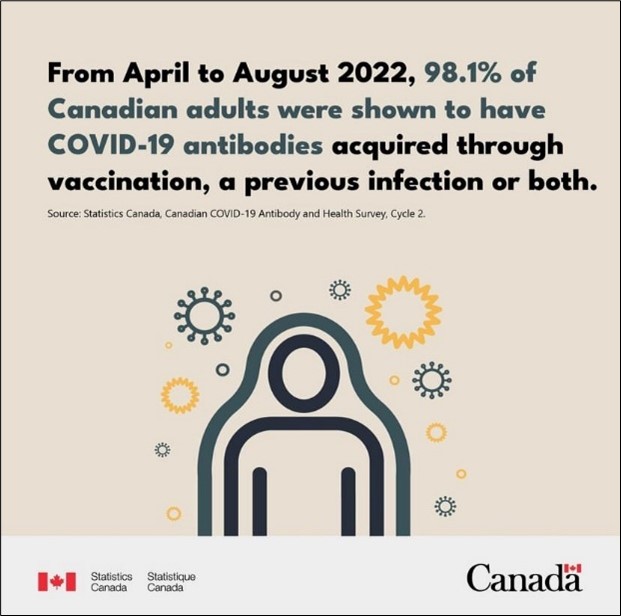
Description - COVID-19 antibodies
From April to August 2022, 98.1% of Canadian adults were shown to have COVID-19 antibodies acquired through vaccination, a previous infection or both.
Source: Statistics Canada, Canadian COVID-19 Antibody and Health Survey, Cycle 2.
- Statistics Canada, in partnership with the Public Health Agency of Canada and the COVID-19 Immunity Task Force, conducted the second cycle of its Canadian COVID-19 Antibody and Health Survey. This survey is designed to help evaluate the health status of Canadians associated with the COVID-19 pandemic. Data were collected from April to October 2022 and provided Canadians with important information about testing practices, rates of past and current infections, awareness of infections, and the prevalence of long-term symptoms among the Canadian population.
- To support the Government of Canada's zero plastic waste agenda, Statistics Canada developed a pilot physical flow account for plastic material. The first release of these data was in March 2022, and updates were made available in March 2023. This project represents one of the first environmental accounts that estimates the flow of plastics through the Canadian economy and will help to inform policy development by providing increasingly accurate statistics. It has already resulted in the development of new approaches for collecting physical flow accounts. It is a key input for partners such as Environment and Climate Change Canada to develop and implement plastics indicators and to contribute to assessing and reporting on the state of plastics and plastic pollution in Canada.
-
After implementing the Quality of Life Framework for Canada in 2021, Statistics Canada developed indicator definitions and products in 2022–23. This work, done in collaboration with several federal partners, including the Treasury Board of Canada Secretariat, the Department of Finance, Environment and Climate Change Canada, and many others, will facilitate more holistic and horizontal evaluations of the well-being of Canadians. Launched in March 2022, the Quality of Life Hub is a one-stop shop for data on the quality of life of people living in Canada, designed to assist policy makers involved in supporting budgeting and decision making. The hub presents the most recent quality of life data and metadata in a non-technical way that is easily accessible for a wide range of users across the data literacy spectrum.
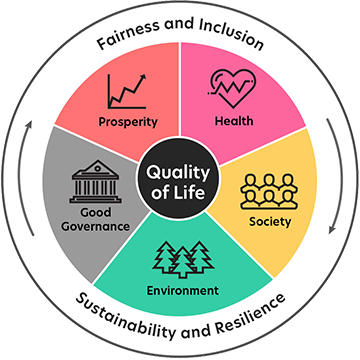
Description - Quality of life identifier
This image illustrates the Quality of Life Framework for Canada. It is represented as a circular graphic with the term "Quality of Life" in a circle at its centre. The circular graphic is divided into five segments which represent each of the five domains of the framework: Prosperity, Health, Society, Environment, and Good Governance. The two lenses of the framework, Fairness and Inclusion and Sustainability and Resilience, encircle the image, represented by curved arrows.
- The infographic Hopefulness in Canada illustrated the insights made possible by the Quality of Life Framework (and the new Canadian Social Survey, which collects quarterly data for many quality of life indicators). It examined how hopeful different segments of the Canadian population—including people with disabilities and the LGBTQ2+ population—generally felt about the future.
Producing business data to address lingering economic uncertainties
- To ensure that Canadians have a full and accurate portrait of labour market conditions, the agency launched the Quality of Employment in Canada publication, through the Labour Force Survey (LFS) supplements program. It aims to fill data gaps on quality of employment and other emerging labour market topics to provide Canadians and organizations with a better understanding of employment characteristics in Canada.
-
The agency increased the sample size of the LFS by 25%. As a result, Canadians have a fuller portrait of labour market conditions, including more detailed information on the labour market experiences of diverse groups, including Indigenous people and racialized people. To better quantify impacts on quality of life, the agency developed and integrated new questions to measure Black and Indigenous business ownership.
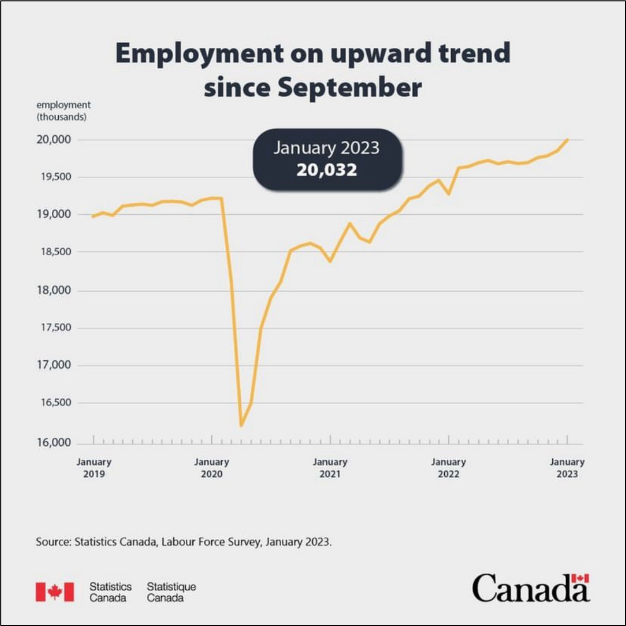
Description - Employment in Canada, January 2019 - January 2023
Employment on upward trend since September
January 2023, 20,032
For employment data for January 2019 to January 2023, please see Chart 1 Employment on upward trend since September of Labour Force Survey, January 2023.
- The LFS was also leveraged to provide insights on ongoing adjustments and structural changes following the COVID-19 pandemic, including labour market churn and wage adjustments in the context of a tight labour market and record-high inflationary pressures. In addition, Statistics Canada updated the Canadian Patent Research Database and made new linkages, such as the Intergenerational Income Database and census linkage, available in research data centres. Statistics Canada consulted and engaged with internal and external partners to identify themes and topics for forthcoming data collection, including the LFS supplements program.
- The agency recognized the increasing need of Canadians for timely information as the business community faced several challenges during the COVID-19 pandemic, including with global supply chains, inflation and labour shortages. As a result, Statistics Canada developed the Canadian Survey on Business Conditions. Not only are indicators about these challenges from this survey disseminated on a quarterly basis, but significant portions of the survey content are modified to meet the evolving needs of key stakeholders.
Further integrating social and business data
- In a time of rapid social and economic changes, Canadians saw value in having access to more integrated social and business data.
-
The Longitudinal Business Database was launched, improving the way the agency tracks the lifecycle of businesses. It provides a foundation to produce better and more coherent information about how businesses are doing, what makes them succeed and the extent to which business ownership is diversifying.
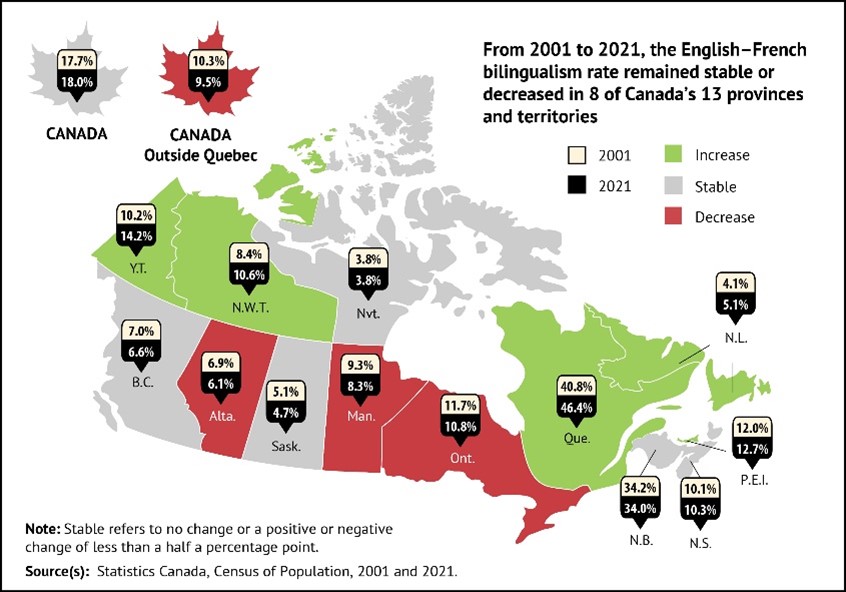
Description - English-French bilingualism rate
From 2001 to 2021, the English–French bilingualism rate remained stable or decreased in 8 of Canada's 13 provinces and territories.
English–French bilingualism rate Rate of bilingualism in both official languages 2001 2021 Change from 2001 to 2021 Canada 17.7 18.0 Stable Canada outside Quebec 10.3 9.5 Decrease Newfoundland and Labrador 4.1 5.1 Increase Prince Edward Island 12.0 12.7 Increase Nova Scotia 10.1 10.3 Stable New Brunswick 34.2 34.0 Stable Quebec 40.8 46.4 Increase Ontario 11.7 10.8 Decrease Manitoba 9.3 8.3 Decrease Saskatchewan 5.1 4.7 Stable Alberta 6.9 6.1 Decrease British Columbia 7.0 6.6 Stable Yukon 10.2 14.2 Increase Northwest Territories 8.4 10.6 Increase Nunavut 3.8 3.8 Stable Note: Stable refers to no change or a positive or negative change of less than a half a percentage point.
Sources: Statistics Canada, Census of Population, 2001 and 2021. - Statistics Canada developed a statistical geomatics vision to give Canadians additional geolocated insights on the environment, society and the economy. Integrating data by geography provides communities with the information they need to make better decisions and allows statistical and geospatial data to be used efficiently. It also enables key internal and external partnerships to be developed in geomatics, ensuring that Statistics Canada continues to be a trusted leader for Canadians in the field of statistical geomatics and geoanalytics.
Meeting the evolving data needs of official language minority populations
- To provide Canadians with evidence-based data on themes affecting official language minority populations, Statistics Canada developed the Survey on the Official Language Minority Population. It was conducted from May to December 2022 in close collaboration with Canadian Heritage. The survey fills data gaps and measures changes in the circumstances of official language minority populations since 2006, when the last similar survey was conducted. The results are scheduled for release in 2024.
- Statistics Canada redesigned the Language Statistics portal in 2022–23 to serve as a one-stop shop for key users of the agency's language data. It provides members of official language minority communities across the country with easy access to a range of data at various geographic levels and on multiple language-related themes. Researchers, academics, government officials and other Canadians can also find a variety of products on languages in Canada.
- In addition, Statistics Canada carried out external outreach and training activities through webinars and other capacity-building activities. For example, as part of its 2021 Census webinar series, Statistics Canada organized two language-specific events open to the public. These provided important information on concepts and definitions; national, provincial and territorial highlights; and guidance on how to access data products and online resources. The Language Statistics Program also actively promoted all analytical products to partners and data users so they could benefit from these data.
Connecting with Canadians in a digital world
Introduced in January 2022, the StatsCAN app is another way the agency has modernized the way data are published. This free mobile application provides trusted, unbiased facts, visuals and key information on demand. It reached over 11,000 downloads within the first year of its launch, enabling users to stay on top of the country's latest statistical news any time they want.
- As Canada's national statistical agency, Statistics Canada needs to remain relevant and reach Canadians with the valuable data they need, in ways that are interesting, informative and easily digestible. To ensure that statistical information reaches more Canadians in more ways, the agency disseminated its products in various media.
-
The agency's Eh Sayers podcast continued into its second year and remained dedicated to meeting the people behind the data and exploring the stories behind the numbers. Eh Sayers reached the top spot in Canada on the Apple Podcasts Government chart, beating out the BBC, The Financial Times, CBS News and the Lincoln Project in 2022. Eh Sayers was highlighted in the 29th Annual Report to the Prime Minister on the Public Service of Canada as an example of innovation and the power of using new storytelling tools to reach Canadians.

- StatsCAN Plus, the agency's second official release vehicle, alongside The Daily, continued to ensure that Canadians were on top of the country's statistical news throughout the day. Its short stories cover a wide range of topics of interest to Canadians. In 2022, more than 250 stories were published, which received over 100,000 visits.
- Statistics Canada advanced the Connecting with Canadians: Publishing Strategy to evolve and modernize the way in which it communicates with Canadians. Under the strategy, the agency continued to adapt its publishing model to meet the changing needs and behaviours of Canadians and ensure they are getting the data they need, in a timely and flexible manner that suits them.
- An innovative communications campaign was launched to promote the 2021 Census of Population and Census of Agriculture data releases not only to regular users, but also to the public, schools, universities, libraries, non-profit organizations, businesses and municipalities. The campaign's reach was further extended through collaborations with federal partners, statistical organizations and social media influencers. Various tools, such as an interactive census game, school and community supporter toolkits, lifestyle articles, webinars, and events, were used to present informative and engaging data insights.
Building and maintaining public trust and understanding

- Statistics Canada's Trust Centre remained an important focus. It aims to increase the transparency of the agency and maintain and consolidate the relationship of trust it has with Canadians, and it is continuously maintained and kept up to date. By providing information on data collection and use, privacy, and more, the Trust Centre is a useful tool for survey respondents, data providers and the media, who can find answers to their questions or concerns on the platform.
Accelerating research through increased microdata access
- Statistics Canada and the Canadian Chamber of Commerce established the Business Data Lab (BDL) to put data to work for Canadian businesses and help them tap into the agency's wealth of economic data. The BDL hosts multiple sources of data on a secure platform to generate important information and provide access to it for businesses and policy makers. Additional tools will be developed for the BDL to closely monitor economic activity as the business community continues to recover from the impacts of the pandemic and new economic uncertainties.
- Leveraging the BDL and its partnership with the Canadian Chamber of Commerce, Statistics Canada recognized the importance of increasing access to microdata. Thanks to this unique partnership, the chamber recently released a new suite of dashboards, called the Business Conditions Terminal, where users can find detailed insights on business activity taking place in major Canadian cities since the beginning of the COVID-19 pandemic.
 Using leading-edge methods of data collection and integration
Using leading-edge methods of data collection and integration
To respond to the increasing need for integrated analysis and insights in a fast-changing world, Statistics Canada continued to leverage its expertise in these areas to ensure that it remained a world-leading agency producing data that Canadians can trust. Statistics Canada integrated data from multiple sources on society, the economy and the environment to develop a better understanding of the complexity of modern-day Canada. The agency worked toward this goal through these initiatives:
- modernizing survey collection methods
- streamlining business processes
- preparing for the 2026 Census
- maintaining world-class frameworks and practices for privacy, data ethics and data stewardship
- increasing capabilities to turn data into insights
- using data to support the recovery of the tourism sector
- monitoring a highly fluid economy with real-time estimates
- leading the development of the world's first Census of Environment
- monitoring sudden shifts in business conditions.
Modernizing survey collection methods
- As part of the ongoing AgZero initiative, Statistics Canada minimized response burden on farmers by replacing survey data typically collected by the Agriculture Statistics Program with data obtained using alternative methods. The initiative also leveraged data and advanced technologies such as Earth observation and machine learning. In 2022–23, the agency successfully replaced a field crop survey that traditionally involved 11,500 farmers. This new approach uses alternative sources and modelling techniques to deliver the same high-quality information while reducing the number of surveys crop farmers need to complete. Additionally, through a partnership with the Canadian Pork Council, AgZero used PigTRACE data to generate reports on interprovincial hog movements without directly contacting farmers.
Streamlining business processes
- The agency continued to optimize and harmonize the process flows, concepts and classifications used to produce the Canadian System of Macroeconomic Accounts (CSMA), while strengthening and modernizing the information technology (IT) infrastructure required for current and future efforts. This will improve data sharing through harmonization and data system interoperability with international statistical organizations.
- In 2022‒23, the agency worked to enhance the catalogue of data available under the Statistical Data and Metadata Exchange (SDMX), an international initiative that aims to improve the exchange of data between organizational units, other government departments and international partners. The initiative introduced a preliminary Canadian System of National Accounts Data Structure Definition under the SDMX framework, with standardized classifications to be used as building blocks for future development. Also, through this initiative, the initial IT platform was deployed, and two CSMA program components were recreated as prototypes in the new environment.
Preparing for the 2026 Census
- As planning begins for the 2026 Census of Population, Statistics Canada identified responsible and innovative ways to reuse information that Canadians have already provided. This will help increase efficiency and time savings for both the agency and Canadians.
- To meet ever-increasing needs for varied and detailed data while enabling the efficient use of cloud services and the robust protection of Canadians' private information, a new internal service—the Statistical Building Register—was implemented. It replaces the existing Address Register, which successfully supported census collection for 30 years. The updated register will be a central data infrastructure tool for the 2026 Census.
- Statistics Canada engages in a formal consultation process at the start of each census cycle, when it invites data users, stakeholders and the public to provide feedback on what information they use, for what purpose they use it, and whether there are emerging data needs that the agency should consider addressing in the next census cycle. This allows Canadians to have a hand in how the agency supports them.
- The agency held hybrid consultation sessions with partners from all levels of government, as well as key census data users, who also received an electronic questionnaire.
- Over a three-month period, Statistics Canada engaged 24 federal departments and stakeholders in consultations. This led to almost 3,000 responses, an improvement from the previous cycle.
Maintaining world-class frameworks and practices for privacy, data ethics and data stewardship
- In keeping with principles outlined in Canada's Digital Charter, Statistics Canada fully implemented its data ethics frameworks and continued to look for ways to strengthen them in light of international developments in an ever-changing digital world. The agency is a world-class leader with state-of-the-art approaches, and it partnered with other countries. For instance, it worked with the United Kingdom to produce an in-depth review on data ethics for the United Nations Economic Commission for Europe (UNECE).
- Statistics Canada was a key partner in renewing the Data Strategy for the Federal Public Service, along with the Privy Council Office and the Treasury Board of Canada Secretariat. Launched in spring 2023, this strategy keeps pace with evolving digital and data environments by improving data management across the federal government to better deliver programs and services to Canadians. Statistics Canada's data stewardship practices were key to establishing government-wide priorities within the strategy, including tangible actions such as the adoption of data standards for federal organizations to implement over the next three years.
Increasing capabilities to turn data into insights

Description - Inflation in Canada
What sector is causing the most inflation in Canada?
Three components of the CPI are contributing the most to consumer inflation:
- Shelter
- Food
- Transportation
- Statistics Canada expanded its data science and data modelling capabilities to better position itself for the high-value work of producing not only data, but also data-driven insights.
- Statistics Canada integrated high-frequency data into the development of models for producing leading economic indicators. For example, the Consumer Price Index (CPI) began annual basket updates in 2022. As Canada faced its highest inflationary period in nearly four decades, having the highest-quality inflation measures was paramount. The updates to the basket items and weights allowed the CPI to more accurately reflect the latest relative importance of the goods and services purchased by Canadians. Frequent basket updates—an internationally recognized best practice—are important to ensure the CPI can respond quickly to changes in consumer behaviours and preferences.
- Statistics Canada developed a microsimulation and modelling program that enables an analysis of the impacts of potential socioeconomic changes and provides enhanced insights on trends. For example, the program gives experts and decision makers information about the impacts of health prevention strategies on chronic conditions, as well as about the economic implications of different policies on retirement and pensions.
- The agency is proud of the successful delivery of the Data Analytics as a Service platform, after five years of dedicated efforts. This cloud-based platform has 864 current users and is revolutionizing the way data scientists and researchers use and share statistical information securely. The agency also continued to expand partnerships across the federal government to enhance and support secure, data-enabled policies to deliver services for Canadians.
- The platform supported key projects at the agency, such as the BDL, as well as the Canadian COVID-19 Antibody and Health Survey, developed in collaboration with the Public Health Agency of Canada, to analyze survey data and prepare releases.
Using data to support the recovery of the tourism sector
- To help the tourism sector recover from the effects of the pandemic, Statistics Canada relied less on survey-based data and focused more on broadening the use of administrative data. This produced more timely snapshots of the industry, resulting in better, real-time data to improve evidence-based decision making. An example is the Canadian Tourism Activity Tracker, which is continually being refined to provide a detailed, up-to-date picture of how the sector is evolving beyond the pandemic, allowing Canadians to adapt and adjust.
- The agency also developed the Frontier Counts: Interactive Dashboard through the International Travel Survey to provide counts of entries by international travellers at Canadian ports of entry. The dashboard was launched in March 2023 and displays current and historical data on the number of border crossings in an interactive and customizable format that includes only those travelling for tourism-related purposes. Updated twice per month, it includes four visualizations: a leading indicator of air arrivals, a leading indicator of land arrivals, returning Canadians and visitors to Canada. This dashboard allows more data about the travel and tourism sector to reach Canadians more quickly, for better planning.
Monitoring a highly fluid economy with real-time estimates
- To monitor the impact of government pandemic-relief benefits on low-income families, the agency produced experimental weekly income estimates, providing timely updates on the evolution of family income.
- The Canadian Social Environment Typology, an example of these releases, is a new tool to help measure health and social inequalities in Canada. It provides neighbourhood classifications based on combinations of 30 socioeconomic, demographic and ethnocultural variables, and each neighbourhood type is a group of census dissemination areas with similar social characteristics. This information can be used to measure health and social inequalities by comparing outcomes with those in other types of neighbourhoods within the same city or in other cities in Canada.
- Another example of the benefit of real-time estimates is the release of information through the DDAP on how different population groups—notably, racialized and low-income populations—have been impacted by the pandemic in significantly different ways. The analytical article COVID-19 mortality among racialized populations in Canada and its association with income looks at COVID-19 mortality among racialized populations, and then further disaggregates it by income within these populations.
Leading the development of the world's first Census of Environment

- Statistics Canada is responding to Canadians' increasing concerns about the economic, social and health risks to communities because of climate change.
- The agency is leading the development of the world's first Census of Environment, which aims to improve Canadians' knowledge about the country's ecosystems, monitor related trends in ecosystems and promote better decision making as a means of improving how Canada responds to global environmental challenges.
- Results began to be released in January 2022. Statistics Canada published several in-depth reviews, including on ecosystem changes, ocean and coastal ecosystem extent, and protected and conserved ocean and coastal ecosystems. New data on salt marshes were also released, along with a framework to track their presence, health and services over time.
- Biodiversity degradation is a key priority for government action. Meeting this complex challenge requires measuring and integrating environmental, social and economic data to inform a range of important investment and policy decisions across the country.
- This ongoing program will deliver a full picture of the complex relationship between ecosystems and the economy, society and human well-being through mapping, tracking and analyzing these areas.
- The agency also released updated time-series data on urban greenness for over 1,000 populated places in Canada. Several other releases are planned for coming years.
- In addition to releasing new data products, the agency engaged with the Canadian public on ecosystem priorities for the Census of Environment. The data collected were used to determine the 2023–24 priorities. The agency also organized engagement activities with experts on specific environmental topics, such as wetlands and salt marshes, which will help guide and improve future work in the Census of Environment program.
Monitoring sudden shifts in business conditions
- The pandemic has highlighted the need to improve the timeliness of statistics to monitor sudden shifts in economic activity. The Real-time Local Business Conditions Index was launched to provide experimental statistics on a weekly basis and track local economic recovery throughout the pandemic. Currently, it serves more than 860 users.
- Through an established partnership with the Canadian Chamber of Commerce, and by using the BDL, Statistics Canada was able to expand the index. It now serves as a signal on the economic conditions of 30 metropolitan areas across Canada by integrating Statistics Canada data with real-time data from alternative sources on business openings and closures and road traffic flows in the commercial areas of each population centre. Consultations with users indicated that the index is tracking major shocks (natural disasters, protests, public health restrictions, etc.) that affect business conditions at the local level in near real time.
 Building statistical capacity and fostering data literacy
Building statistical capacity and fostering data literacy
In 2022–23, Statistics Canada worked on new ways to present data that are more compelling and accessible to Canadians, supporting evidence-based decision making at every level in a rapidly changing world. Activities included
- strengthening the statistical system
- adapting to the digital world
- measuring sustainable development
- harnessing data to support Indigenous self-determination
- leveraging new approaches and technologies
- fostering data literacy to encourage evidence-based decision making.
Strengthening the statistical system
- The agency continued to evolve, grow and innovate the national statistical system, with the support of advisory groups such as the Canadian Statistics Advisory Council. The council's recommendations—including the ones contained in its latest annual report, Trust, Governance and Data Flows in the National Statistical System help Statistics Canada achieve its primary goal of ensuring that Canadians and governments continue to have access to a trusted source of statistics, while preserving privacy and confidentiality. As a result, Canadians have better access to data, provided in a modern, ethical and responsible way.
Adapting to the digital world
- In alignment with its modernization vision, Statistics Canada leveraged the opportunity to work with the workload migration program at Shared Services Canada to
- enable a new generation of digital service delivery offerings for Canadians
- ensure that existing government applications are migrated off aging and vulnerable IT infrastructure
- deliver on the government's vision of a modern, digitally enabled public service, as well as its drive to prioritize cloud-based computing.
- Statistics Canada moved close to 100% of applications and services from its aging Tunney's Pasture data centre to a cloud environment. This was the first time a cloud migration of this scale has been completed in the public service.
- The benefit to Canadians is clear: the agency's secure cloud environment is foundational for transforming Statistics Canada's services to Canadians. These are shifting away from simple data tables and toward enhanced data analytics capabilities, greater access to data through user-friendly tools, and an increased value proposition through improvements to data quality and timeliness.
- For the agency, keeping pace with change and innovation has improved
- its risk posture
- its organizational agility
- the user experience
- data access, collaboration and sharing
- the security of its sensitive statistical information.
Measuring sustainable development
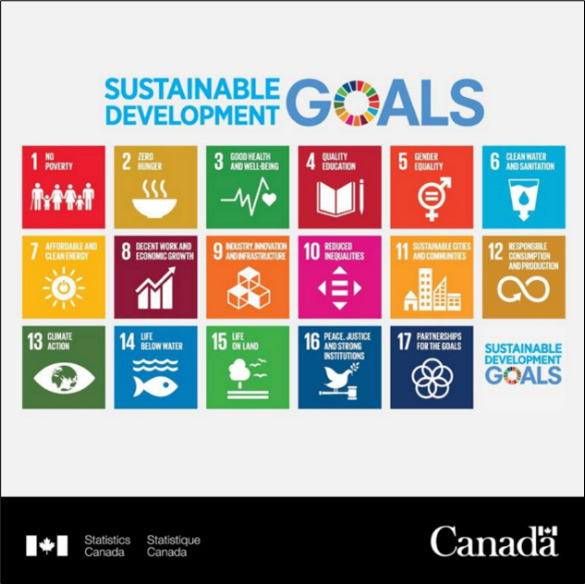
Description - Sustainable Development Goals
Sustainable Development Goals
- No poverty
- Zero hunger
- Good health and well-being
- Quality education
- Gender equality
- Clean water and sanitation
- Affordable and clean energy
- Decent work and economic growth
- Industry, innovation and infrastructure
- Reduced inequalities
- Sustainable cities and communities
- Responsible consumption and production
- Climate action
- Life beyond water
- Life on land
- Peace, justice and strong institutions
- Partnerships for the goals
- The agency has been significantly involved in work to meet the Sustainable Development Goals, part of the global 2030 Agenda for Sustainable Development. Statistics Canada also co-chaired the United Nations (UN) Inter-agency and Expert Group on Sustainable Development Goal Indicators.
- Statistics Canada chairs the United Nations Network of Economic Statisticians, the UN Committee of Experts on Environmental-Economic Accounting, the Organization for Economic Co-operation and Development Committee on Statistics and Statistical Policy and co-chairs the United Nations Inter-Agency Expert Group on Sustainable Development Goals Indicators. Statistics Canada's involvement in these committees is essential, as it shows that Canada, through the agency, is exerting leadership and influence, while sharing Canadian values internationally.
- Statistics Canada developed a large number of indicators that help track Canada's progress toward meeting the Sustainable Development Goals. To better inform Canadians, the agency created infographics; in 2022–23, goals 1 to 11 were covered. Infographics on the remaining six goals will be released during the second quarter of 2023–24.
- The agency meaningfully contributed to meeting the Sustainable Development Goals and supported capacity building in other countries through initiatives such as the Project for the Regional Advancement of Statistics in the Caribbean. Through this project, Statistics Canada helped Caribbean countries
- conduct their censuses while considering the challenges raised by pandemic restrictions
- improve the coverage of business populations with the use of administrative data
- increase the visibility of national statistical offices by modernizing their websites, making data more easily findable, highlighting the most recent releases and providing more data visualization
- complete their statistical business registers and finalize their communication and dissemination development.
Harnessing data to support Indigenous self-determination
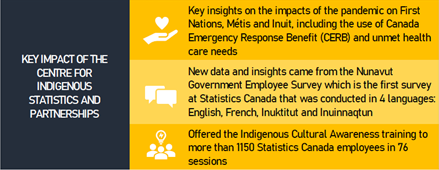
Description - Key impact of the Centre for Indigenous Statistics and Partnerships
- Key insights on the impacts of the pandemic on First Nations, Métis and Inuit, including the use of Canada Emergency Response Benefit (CERB) and unmet healt care needs.
- New data and insights came from the Nunavut Government Employee Survey which is the first survey at Statistics Canada that was conducted in 4 languages: English, French, Inuktitut and Inuinnaqtun.
- Offered the Indigenous Cultural Awarenesss training to more than 1150 Statistics Canada employees in 76 sessions.
- In 2022–23, Statistics Canada, through its Centre for Indigenous Statistics and Partnerships, accelerated its efforts to strengthen data capacity among First Nations people, Métis and Inuit. The Transformational Approach to Indigenous Data helps communities advance self-determination and respond to distinct and evolving service delivery needs. This approach includes new data investments and the co-development of data and research projects that help First Nations people, Métis and Inuit achieve the capacity needed to collect, manage and use their own data, for their benefit. The agency is also improving the visibility of Indigenous peoples through the availability of national statistics.
- The Indigenous Statistical Capacity Development Initiative, led by the Centre for Indigenous Statistics and Partnerships, supported Indigenous organizations and communities looking to develop and sustain their own statistical capacity by providing training on various topics related to statistics.
- In November 2022, Statistics Canada released poverty estimates for Yukon and the Northwest Territories for the first time. These estimates were the culmination of a collaboration between Statistics Canada, Employment and Social Development Canada, and the territorial governments.
Leveraging new approaches and technologies

- This past year, the agency invested in machine learning to enhance alternative data collection and use. This included identifying foods in images for health surveys, extracting product information from receipts, and finding location-relevant content in unstructured financial documents. Statistics Canada also developed a flash estimation method for electricity generation with significantly lower error rates, contributing to a reduction of manual work.
- Furthermore, the agency led monthly events for the public to share and engage with data and to bring data and insights into decision making for the benefit of all Canadians. The agency led monthly hackathons on a variety of topics, including climate change, workplace health, and grants and contributions. These collaborative events helped tackle real challenges by inviting partners with diverse experiences, skills and perspectives from across the public, private and non-profit sectors to co-create innovative solutions with agency experts.
Fostering data literacy to encourage evidence-based decision making
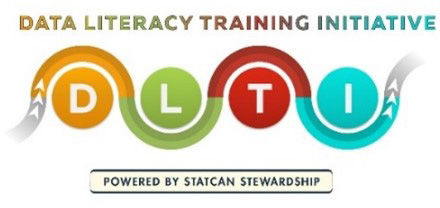
- Statistics Canada expanded training resources and shared them freely with users through its Data Literacy Training Initiative. Since its release in 2020, this initiative has received over 150,000 visits and over 300,000 page views. The agency also worked with partners across the federal government to build capacity among public servants. New training products have been incorporated into the data literacy training of several federal departments.
 Collaborating and engaging with partners
Collaborating and engaging with partners
To better respond to the information needs of Canadians, Statistics Canada strengthened partnerships and collaborated with all levels of government, international partners and other organizations. The agency continued to improve local data and track changes in trends to optimize new and existing initiatives that benefit Canadians. To meet these objectives, the agency has been
- collaborating with provinces and territories to improve health outcomes
- partnering to improve knowledge about Northern Canada
- improving local data for better decision making
- pursuing partnerships to develop data about zero emissions
- collaborating to improve education and labour-market outcomes
- making a difference on the world stage.
Collaborating with provinces and territories to improve health outcomes
- Throughout 2022–23, the agency explored trends in provisional causes of death, including drug overdose, and their effect on excess mortality. It also continued to publish monthly releases on deaths and excess mortality using the Canadian Vital Statistics - Death database, which collects information from all provincial and territorial vital statistics registries through a partnership with the Vital Statistics Council for Canada. The data were accompanied by analyses that considered how they were affected by factors such as COVID-19 variants, heat waves and alcohol, and they were disaggregated in various ways, including by age and sex. These insights are a key input in creating public health policies. They were featured in statements by chief public health officers, as well as in media coverage.
- In spring 2022, the agency launched the Community Fire Risk Reduction Dashboard, a geospatial pilot project co-developed by Statistics Canada and the British Columbia Office of the Fire Commissioner. It uses census data and data from the National Fire Information Database on fire deaths and fire-related crimes. This tool visually highlights the fire risk at the neighbourhood level to help British Columbia fire services prevent fires, reduce injuries and save lives. With the collaboration of fire safety partners and emergency managers, the agency plans to turn this pilot project into a national tool that could assist with other disaster risk reduction efforts, such as wildfires and floods.
- In addition, in 2022–23, the agency worked with fire safety partners across Canada to increase analysis and improve insights on fire deaths and fire-related crimes.
Partnering to improve knowledge about Northern Canada
- Under the Northern Data Strategy, the agency continued to promote innovative solutions to fill data gaps in the North through partnerships with the Yukon and Northwest Territories bureaus of statistics.
- The Northern Data Strategy was used to develop the Northern Canada Social Survey (NCSS) as the primary survey collection vehicle in the North, to help manage the agency's survey footprint in the region. Managing this footprint is integral to the agency's long-term ability to collect survey data. When launched, the NCSS will streamline household collection and address issues of survey burden and fatigue. The agency engaged with federal, territorial and Indigenous partners to ensure that the NCSS will meet key data needs. This work is supported by a strong governance framework to make sure that survey scheduling, collection strategies and content follow best practices to respond to Northern realities.
Improving local data for better decision making
- Statistics Canada continued to strengthen its partnership with the Federation of Canadian Municipalities to better understand the data needs of communities of all sizes and support evidence-based decision making.
- The agency aims to provide detailed statistics to municipalities and their residents via improved access to municipal-level and disaggregated data and greater data sharing and collaboration.
- The agency fulfilled this commitment over the past year by launching the beta version of the Municipal Data Portal, the Centre for Municipal and Local Data, and the experimental Municipal Financial and Socioeconomic Data Dashboard.
- In addition, the agency established a detailed communications and engagement plan that focuses on improving data literacy through webinars, data sessions and data bootcamps.
- This partnership with municipalities allows academic groups to make municipal data more accessible, thereby improving the availability of municipal-level statistical information and services to communities. It also ensures that municipalities have the necessary knowledge and staff to assess data for their own needs, ultimately building trust with local communities.
Pursuing partnerships to develop data about zero emissions

Description - New motor vehicles
Canadians registered 431,861 new motor vehicles in the second quarter.
Source: Statistics Canada, Table 20-10-0024-01 New motor vehicle registrations, quarterly.
- In December 2022, the transportation statistics program resumed the national vehicle registration counts for Canada and the provinces. The series now includes enhanced vehicle type categories and key information about fuel type, including zero-emission vehicles, which can be viewed using the New Motor Vehicle Registrations Data Visualization Tool. These enhancements represent an important step along Canada's path toward reducing greenhouse gas emissions, and they provide the transportation industry and energy policy research community with key benchmark indicators on how the Canadian motor vehicle fleet is evolving.
- Transport Canada has mandated a zero-emission vehicle sales target of 100% by 2035, including interim targets of at least 20% by 2026 and at least 60% by 2030. The interactive visualization tool makes it easier to access and use these data, with a brand-new cloud-based method to derive vehicle counts and data visualizations to help determine the infrastructure required to support the fleet, such as the location of charging stations.
Collaborating to improve education and labour-market outcomes

Description - Racialized graduates with a Canadian bachelor's degree
From 2014 to 2017, 30% of graduates who completed a bachelors's degree at a Canadian educational institution were from a racialized group.
Source: Galarneau, Diane, Liliana Corak and Sylvie Brunet. 2023. "Early career job quality of racialized Canadian graduates with a bachelor's degree, 2014 to 2017 cohorts". Insights on Canadian Society. January. Statistics Canada Catalogue no. 75-006-X.
- The Education and Labour Market Longitudinal Platform (ELMLP)—the result of partnerships between Statistics Canada, Employment and Social Development Canada, and the provinces and territories—fills data gaps and enables a greater understanding of student and apprentice pathways, transitions to the labour market, and outcomes over time. In 2022–23, the ELMLP enabled the development and release of new and meaningful insights on the labour market and economic trajectories of postsecondary students. For instance, two new studies on the relationship between educational attainment and occupation for racialized populations were released.
- In addition, the agency created the Elementary to Postsecondary Student Education Dashboard: Enrolments, Graduations and Tuition Fees. This dashboard amalgamates three education surveys to provide insights throughout student pathways.
- In partnership with Natural Resources Canada, the Canada Energy Regulator, and Environment and Climate Change Canada, Statistics Canada continued to expand access to energy information through the Canadian Centre for Energy Information (CCEI). More than 850 data products from 120 different sources are currently available on the CCEI portal.
- In 2022–23, new content on topics such as uranium and nuclear power was added, and data on household spending on energy were enhanced. In addition, a new section on energy and the environment was launched in June 2022. It features 11 new data visualizations and 17 indicators on energy-related environmental topics, and it provides better access to data on greenhouse gas emissions from both Statistics Canada and Environment and Climate Change Canada.
- Work is also ongoing this year to improve energy data quality and reduce data gaps. This includes launching a pilot project to publish a dashboard of publicly available high-frequency electricity data from utilities and expanding the Monthly Renewable Fuel Survey.
Making a difference on the world stage
- Statistics Canada exercised significant leadership in the international statistical system, including
- in leading roles in the Conference of European Statisticians and the UNECE, on topics such as quality of life and statistics on children
- as chair of the Committee on Statistics and Statistical Policy of the Organisation for Economic Co-operation and Development
- as chair of the UN Network of Economic Statisticians
- as chair of the UN Committee of Experts on Environmental-Economic Accounting
- as chair of the High-Level Group for the Modernisation of Official Statistics.
- The agency is also examining the organizations and groups it is involved with to ensure that engagement in the international statistical system is done thoughtfully and strategically and that there is no duplication. Statistics Canada's involvement in these committees shows that Canada, through the agency, is exerting leadership and influence, while sharing Canadian values internationally.
 Building an agile workforce and workplace
Building an agile workforce and workplace
In 2022–23, Statistics Canada renewed its human resource planning framework, which enables leaders to establish individualized strategies for recruitment and development, as well as to track progress toward their people-management goals. This allows the agency to continue to support the information needs of Canadians. Activities included
- taking the pulse of employees to respond to their evolving needs
- building a diverse and inclusive workforce
- promoting official languages in the workplace
- making progress on public service renewal.
Taking the pulse of employees to respond to their evolving needs
- In January 2023, the Human Resources Business Intelligence Portal was launched for all executives and assistant directors in the agency. The portal incorporates new cloud technology and respects accessibility best practices to provide a simple user interface that encompasses all human resources data in a centralized location. It is scheduled to be made available to all Statistics Canada employees by mid-2023. It will enable employees to access important resources, view their employment information securely and respond to internal surveys. The portal will make it easier for leaders and employees to use, analyze, contribute to and share the data they need to make more efficient and evidence-based decisions that support organizational health and efficiency.
- Leveraging its expertise in organizational health, the agency partnered with academics and organizations across the federal public service to produce and share research about organizational psychology and employee wellness. This includes detailed research and measurement guidance on engagement and hybrid work, with a committee chaired by the Office of the Chief Human Resources Officer.
- The 2022–23 Public Service Employee Survey was launched in November 2022 in partnership with the Treasury Board of Canada Secretariat. It represents an important opportunity for public servants to share their experiences and improve the quality of their workplace. The data collected allow for informed decisions on people management in the public service.
Building a diverse and inclusive workforce

- In 2022–23, Statistics Canada continued to prioritize equity, diversity and inclusion. It made great progress on the commitments and actions in the multi-year Equity, Diversity and Inclusion Action Plan: Moving Forward Together by completing or beginning 47 of the 50 commitments identified for the first year.
- In this action plan, Statistics Canada committed to data transparency and the provision of disaggregated data to all employees and managers. To this end, the agency released quarterly equity, diversity and inclusion progress reports in 2022–23. These reports shared information on promotion rates for equity-seeking employees across the four designated groups, as well as key insights for a range of indicators, such as the participation of equity-seeking employees in official language programs, workforce representation rates, regional representation and the retention of diverse talent. The reports also served to raise awareness on how the agency is progressing in meeting the collective equity, diversity and inclusion goals, and they helped drive evidence-based decision making. Additional reports specific to Black and Indigenous employees were released, with a focus on representation rates, official language training programs, and recruitment and hiring processes and practices (including for promotions).
- Since 2021, the representation of all designated groups among executives has not only increased but surpassed workforce availability (WFA) rates.
- As of March 31, 2023, women's representation among executives reached 50.0%, surpassing the WFA rate of 44.5%, while the representation of racialized people at the executive level was 16.7%, exceeding the WFA rate of 13.9%. Indigenous representation among executives reached 4.6%, surpassing the WFA rate of 4.2%, while the representation of people with disabilities at the executive level was 15.7%, more than double the WFA rate of 5.4%.
- Representation also increased in feeder groups, supporting the continued diversity of tomorrow's executive cadre. This representation on the leadership team has had and continues to have a profound impact on the agency's culture.
- In addition, Indigenous employees and Black and other racialized employees reached their highest representation to date. Turnover rates of equity groups were at their lowest in comparison with the last five fiscal years.
- To ensure that equity-deserving representation is better reflected on hiring boards, there is an internal inventory where people who have self-identified can be selected to sit on a board. As part of Statistics Canada's employment equity recruitment efforts, it was established that, going forward, the areas of selection for job postings will prioritize employment equity group members. As priority is given to employment equity group members when it comes to appointments, this is also being reflected in language training.
-
Statistics Canada launched self-identification campaigns over the course of the fiscal year and shared various awareness communications. Representation rates for all designated groups exceeded WFA rates at the agency level, as a result of targeted staffing processes; commitments in the Equity, Diversity and Inclusion Action Plan: Moving Forward Together; and self-identification awareness campaigns. Specifically, at the end of fiscal year 2022–23, representation across the designated equity groups was as follows:
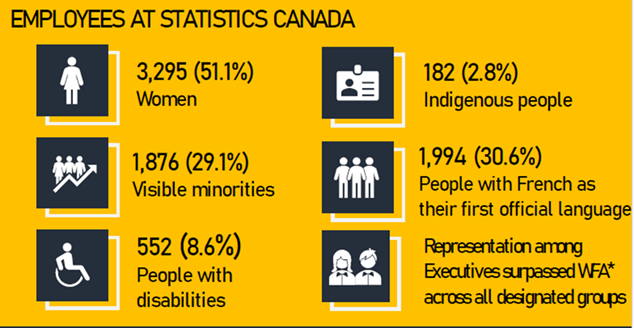
Description - Employees at Statistics Canada
Employees at Statistics Canada
- 3,295 (51.1%) Women
- 1,876 (29.1%) Visible minorities
- 552 (8.6%) People with disabilities
- 182 (8.2%) Indigenous people
- 1,994 (30.6%) People with French as their first official language
- Representation among Executives surpassed WFA across all designated groups
- Indigenous people (Statistics Canada: 2.8%; WFA: 1.7%)
- racialized people (Statistics Canada: 29.2%; WFA: 27.2%)
- people with disabilities (Statistics Canada: 8.7%; WFA: 8.5%)
- women (Statistics Canada: 51.0%; WFA: 44.2%).
- Statistics Canada's accessibility action plan serves as a framework to ensure accessibility in services, products and facilities for both employees and the public. The plan articulates the agency's commitment to ensuring that all employees have fair, equitable and barrier-free access to employment opportunities throughout their career—from recruitment to onboarding to development and career advancement.
Promoting official languages in the workplace
- Statistics Canada has continued to implement an agency-wide strategy to ensure that employees have access to language training to fulfill the operational requirements of their jobs.
- The agency has been prioritizing members of employment equity groups for non-imperative appointments and language training. This approach has helped close employment equity gaps and represents an achievement in access to key positions. To ensure that all employees have access to this training, the agency has implemented alternative solutions, while promoting a common approach that strengthens compliance with the Policy on Official Languages. Such solutions include a hybrid training format for distance learning to include employees nationwide, as well as discussion groups to foster second language maintenance. This approach also ensures that resources can be distributed accordingly, while maintaining sufficient bilingual capacity within the agency.
Making progress on public service renewal
By launching the multi-year Statistics Canada: Road to Accessibility, 2023-2025 action plan in December 2022, Statistics Canada committed to preventing, identifying and removing accessibility barriers. This accessibility action plan serves as a framework to ensure accessibility in services, products and facilities for both employees and the public.
- As part of the public service renewal plan, known as Beyond2020, Statistics Canada is dedicated to equipping employees with tools, training and experience to build inclusion and resilience, and to deliver greater value to Canadians.
- The agency continued to build on its leadership strategy, which aligns with current and future initiatives (culture, values, onboarding, talent management, recognition, diversity, official languages and future of work). The strategy focuses on employee ownership and empowerment, where everyone is provided opportunities to develop as leaders. To this end, and as part of a phased approach to the leadership strategy, the agency launched a series of key leadership development activities, refreshed external targeted leadership programs, and increased participation in learning offerings and Canada School of Public Service course attendance. A leadership culture engagement calendar was also launched, sharing over 30 tools and resources (including events, guides, networking opportunities and best practices) with senior leaders across the agency.
Innovation
Statistics Canada's mandate, for more than a century, has been to build the data flows necessary to reveal Canada's realities and challenges. To achieve this means continuing to strengthen the innovation ecosystem with investments, but also building governance, infrastructure and skills development to promote innovation and experimentation. In many ways, the pandemic taught—and continues to teach—the agency lessons in purpose-driven innovation. The agency is now using the lessons learned from its pandemic response to assist in other areas. The following are notable examples for 2022–23:
- Hackathons are a core piece of the agency's infrastructure to drive innovation. The agency continued to host monthly hackathons on a variety of topics—their whole-of-government approach enables knowledge and best practices in data science to be shared among all federal public servants.
- To help policy makers better understand inflation and inform decisions, Statistics Canada applied innovative methods to key economic indicators such as the CPI, the Industrial Product Price Index, the Wholesale Services Price Index and the Retail Services Price Index. The following are examples of how the agency improved timeliness for key economic indicators:
- The Industrial Product Price Index and the New Housing Price Index are now providing results two to three weeks after the end of the reference month, compared with five to six weeks in the past, helping businesses and policy makers make better-informed decisions.
- The wholesale and retail services price indexes are now producing monthly estimates, compared with quarterly in the past, by using advanced machine learning techniques. These have resulted in more efficient and transparent programs, through automation.
- The Producer Prices Division invested heavily in training and revised and updated its methodological practices and overall production processes. As a result, it is producing economic indicators faster and more cheaply (10% lower costs compared with 2020).
- The agency continued to leverage administrative data and experiment with replacing specific variables in surveys with administrative data to see how this could be used to reduce response burden. Initiatives that used these innovative methods include AgZero, the ELMLP and the DDAP Administrative Data Fund.
- Through the DDAP, Statistics Canada successfully mapped out population trajectories and released information on how different population groups, notably racialized populations and low-income populations, have been impacted by the pandemic.
- As part of Canada's Anti-Racism Strategy, a new Social Inclusion portal was created to bring together key statistical information on the inclusion (or exclusion) of ethnocultural groups and immigrants to Canada.
- Statistics Canada committed to a comprehensive accessibility system review and launched the Engaging DisAbility Innovation Study. This employee-led initiative aims to identify barriers for clients and employees with disabilities by introducing design practices that will allow the agency to develop accessible policies, practices, services and programs.
Key risks
Statistics Canada continuously monitors its environment to develop risk mitigation strategies associated with its core responsibility. The agency will continue to adapt its governing instruments and oversight frameworks and engage with Canadians using clear, transparent and proactive communications. It will also keep investing in robust infrastructure—technological and methodological—to ensure the reliability, timeliness, scalability and security of its statistics. The agency identified five corporate risks and corresponding mitigation strategies.
1. Resources
In a competitive labour market, with a need for new skills and a focus on accessibility, equity, diversity and inclusion in the workplace, Statistics Canada faces risks related to the sufficiency of its human resources and its capacity and expertise to deliver on its vast mandate and broad set of priorities.
To mitigate this risk, the agency continued to implement and prioritize actions from its Equity, Diversity and Inclusion Action Plan: Moving Forward Together. This helped strengthen the diversity and inclusiveness of its workforce. Training for using newer, more modern tools was also provided, ensuring a skilled workforce for the future. In addition, the Investment Review Board was launched, with the goal of ensuring an integrated strategic view of the agency while considering affordability, resource availability and long-term funding strategies.
2. Accuracy and integrity
Maintaining the accuracy of data and information holdings—including avoiding major errors—often competes with the need to produce information faster, increasingly complex production environments, the expanding use of multiple data sources and new techniques, and rising information demands.
As part of its risk mitigation, Statistics Canada was active on the international stage, following and participating in leading-edge developments, such as alternative data sources, web scraping, data integration and data sharing. These allow for adjustments to operations that strengthen data privacy and quality, which Canadians expect. In parallel, new methodologies and approaches were developed to improve statistical programs. For instance, the agency continued to work on implementing an integrated approach to data management through the Enterprise Information and Data Management Project.
3. Confidentiality
Without strict controls and safeguards, the agency's vast amount of confidential and sensitive information is susceptible to potential data breaches, wrongful disclosure and cyber security threats.
In addition to a strong culture and value system, Statistics Canada has sound oversight, governance instruments and processes in place to mitigate this risk. The agency continued to be vigilant by proactively reviewing related confidentiality processes and procedures (e.g., the Policy on Official Release) and providing training and raising awareness for all employees and relevant partners on matters related to values and ethics and the overall security of protected information.
4. Public trust
Wrongful disclosures of information, disinformation campaigns and other factors may impact the public's trust in the agency, resulting in Canadians turning to other, less credible sources of information.
Statistics Canada continued to balance the protection of Canadians' privacy and societal needs for data insights by applying the Necessity and Proportionality Framework. It also kept developing and adding to the Trust Centre on its website. In the context of the 2021 Census dissemination activities, the agency also pursued its "Fighting misinformation" campaign to proactively protect Canadians against false information and scamming attempts.
5. Relevance
Growing external demands stemming from a continuously evolving environment may require changes to ensure programs remain relevant.
To mitigate this risk, Statistics Canada embarked on its second phase of modernization and developed a strategic plan to be implemented starting in 2023–24. The outlined priorities will allow the agency to remain committed to increasing relevance by targeting initiatives that will ensure Canadians keep receiving high-quality statistical information that matters. Statistics Canada also continued to improve the quality and availability of disaggregated data in support of the Government of Canada's commitment to evidence-based decision making.
Results achieved
Across the agency, targets were affected by the release of 2021 Census data and were no longer significantly influenced by releases related to the COVID-19 pandemic. The agency continually strives to improve results and ensure targets remain relevant while also aiming to innovate. Overall, for 2022–23, Statistics Canada reached 8 of 11 performance indicator targets, highly exceeding 4 of them.
Heading into fiscal year 2023–24, Statistics Canada will continue to integrate performance indicator results into its decision-making processes to ensure that valuable data are produced and accessed by the Canadian population.
The following table shows, for statistical information, the results achieved, the performance indicators, the targets and the target dates for 2022–23, and the actual results for the three most recent fiscal years for which actual results are available.
| Performance indicators | Target | Date to achieve target | 2020–21 actual results | 2021–22 actual results | 2022–23 actual results |
|---|---|---|---|---|---|
| High-quality statistical information is available to Canadians | |||||
| Number of post-release corrections due to accuracy | 0 | March 31, 2023 | 6 | 7Table note 1 | 11Table note 2 |
| Percentage of international standards with which Statistics Canada conforms | 90%Table note 3 | March 31, 2023 | 88% | 88% | 98%Table note 4 |
| Number of statistical products available on the website | 47,680 | March 31, 2023 | 40,738 | 43,184 | 46,318 |
| Number of Statistics Canada data tables available on the Open Data Portal | 8,450 | March 31, 2023 | 7,755 | 8,088 | 8,884 |
| High-quality statistical information is accessed by Canadians | |||||
| Number of visits to Statistics Canada's website | 24,500,000 | March 31, 2023 | 28,193,955Table note 5 | 45,972,326Table note 6Table note 7 | 31,283,576Table note 8 |
| Number of hits on Statistics Canada's application programming interface (API) | 4,055,000 | March 31, 2023 | 3,899,779 | 5,950,252 | 10,073,000Table note 9 |
| Percentage of website visitors who found what they were looking for | 78% | March 31, 2023 | 77% | 74%Table note 10 | 78%Table note 11 |
| Number of interactions on social media | 1,200,000 | March 31, 2023 | 1,211,316Table note 5 | 13,174,481Table note 6Table note 7 | 1,012,981Table note 12 |
| High-quality statistical information is relevant to Canadians | |||||
| Number of media citations of Statistics Canada data | 78,000 | March 31, 2023 | 253,171Table note 5 | 139,078Table note 7 | 213,229Table note 13 |
| Number of journal citations | 38,000 | March 31, 2023 | 33,596Table note 5 | 40,248Table note 14 | 44,271Table note 15 |
| Percentage of users satisfied with statistical information | 80% | March 31, 2023 | 80% | 80% | 80% |
|
Table notes
|
|||||
Financial, human resources and performance information for Statistics Canada's program inventory is available in GC InfoBase.
Budgetary financial resources (dollars)
The following table shows, for statistical information, budgetary spending for 2022–23, as well as actual spending for that year.
| 2022–23 Main Estimates | 2022–23 planned spending | 2022–23 total authorities available for use | 2022–23 actual spending (authorities used) | 2022–23 difference (actual spending minus planned spending) | |
|---|---|---|---|---|---|
| Gross expenditures | 616,663,357 | 616,663,357 | 754,356,616 | 731,447,169 | 114,783,812 |
| Respendable revenue | -120,000,000 | -120,000,000 | -159,349,013 | -159,349,013 | -39,349,013 |
| Net expenditures | 496,663,357 | 496,663,357 | 595,007,603 | 572,098,156 | 75,434,799 |
Financial, human resources and performance information for Statistics Canada's program inventory is available in GC InfoBase.
Human resources (full-time equivalents)
The following table shows, in full‑time equivalents, the human resources the department needed to fulfill this core responsibility for 2022–23.
| 2022–23 planned full-time equivalents | 2022–23 actual full-time equivalents | 2022–23 difference (actual full-time equivalents minus planned full-time equivalents) | |
|---|---|---|---|
| Gross expenditures | 5,889 | 7,005 | 1,116 |
| Respendable revenue | -1,181 | -1,795 | -614 |
| Net expenditures | 4,708 | 5,210 | 502 |
The difference between planned spending and actual spending in the statistical information program is the result of an operating budget carried forward from 2021–22 to 2022–23 to enable the agency to meet the needs of its cyclical programs and a reprofile of funds to successfully close out the final years of the 2021 Census cycle.
Additionally, new initiatives from Budget 2021 and Budget 2022, as well as other departmental organizations, increased Statistics Canada's resources. These initiatives include the Clean Technology Data Strategy, the Survey of Intellectual Property Commercialization in the Higher Education Sector, the oral health component of the upcoming Canadian Health Measures Survey, the initiative for advancing a circular economy for plastics in Canada and the Federal Action Plan to Strengthen Internal Trade. Compensation was also received for the ratification of collective agreements.
Respendable revenue increased because of additional work associated with extra demands following the slowdown during the pandemic and the 2021 Census.
The increases were partially offset by budget carried forward to 2023–24.
Furthermore, full-time equivalents vary slightly as a result of differences between the actual salary rates paid and the estimated average salary rates used to forecast planned spending.
Financial, human resources and performance information for Statistics Canada's program inventory is available in GC InfoBase.
Internal services
Description
Internal services are those groups of related activities and resources that the federal government considers to be services in support of programs and/or required to meet corporate obligations of an organization. Internal services refers to the activities and resources of the 10 distinct service categories that support program delivery in the organization, regardless of the internal services delivery model in a department. The 10 service categories are:
- acquisition management services
- communication services
- financial management services
- human resources management services
- information management services
- information technology services
- legal services
- material management services
- management and oversight services
- real property management services
Results
Statistics Canada's internal services have been dedicated to continuing to modernize and innovate the agency's workforce, by providing a representative, flexible and accessible work environment and workforce, during a dynamic period.
Through internal planning and the implementation of workforce strategies, the agency continued to focus on creating a diverse and inclusive workforce, more than ever before, while ensuring that all employees and leaders are equipped to make accessibility part of everyday planning. Statistics Canada created inclusive and flexible policies, programs and services, alongside objective internal consultations and audits, to ensure its plans are aligned with workforce needs and foster a positive work environment. The agency's internal services touched on the following areas:
- skillsets and talent management
- accessibility
- internal audit and evaluation
- awards and recognition.
Skillsets and talent management
- The agency made significant advances in implementing the leadership strategy, which aligns current and future initiatives and focuses on digital enablement, diversity and inclusion, and the future of work. The strategy also promotes language training and better positions people to obtain higher-level roles. As a result, representation has increased and the retention of diverse talent has improved. These core elements are critical to ensuring a workforce that best represents today's diverse Canada.
- With an increase in the representation of Black people, people from other racialized groups, Indigenous people, people with disabilities, members of LGBTQ2+ communities and women among employees, and improvements in the retention of this diverse talent, the leadership strategy reinforces the need to prioritize a diverse workforce and support employee career progression. This, in turn, enhances and expands the agency's overall talent pool, making Statistics Canada stronger.
- To this end, the leadership strategy promotes language training for aspiring leaders, to better position them to obtain higher-level positions. As a result, the agency has seen and continues to see a significant impact in diversifying its talent, which better represents the public it serves.
Accessibility
- From March to October 2022, the agency conducted an in-depth independent assessment of accessibility and employment systems to ensure a bias-free view of accessibility barriers. The assessment was centred on data analysis, a document review, employee consultations and focus groups. Its findings served to inform actions committed to in Statistics Canada: Road to Accessibility, 2023-2025. To ensure a "nothing without us" approach, as well as an intersectional perspective, the review included engagement and consultations with participants from various equity seeking groups and sociocultural backgrounds.
- The agency launched the Statistics Canada: Road to Accessibility, 2023-2025 action plan in December 2022. The plan aims to ensure that the agency meets all employees' accessibility needs across the country and supports the implementation of a barrier-free environment. The plan is anchored in areas of focus articulated in the Accessible Canada Act. Through the addition of workplace accommodation and culture pillars, it is bolstered by two additional areas of focus that emphasize the importance of accommodation and an accessibility-confident and disability-inclusive culture.
- To develop this plan, Statistics Canada followed through on several internal commitments to better understand, support and create an inclusive workplace. The agency undertook a comprehensive accessibility and employment systems review, reviewed responses to the Engaging DisAbility Innovation Study (an employee-led initiative launched in partnership with Canadian Heritage and supported by the Office of Public Service Accessibility at the Treasury Board of Canada Secretariat), and participated in engagement consultations with the Persons with Disabilities Committee to articulate actions and commitments across all priority areas.
- In addition to the release of the plan, the agency created the Accessibility Secretariat and the Statistics Canada Accessibility Leadership Taskforce, so that the agency can continue to prioritize accessibility and ensure that its commitments are measurable and attainable and result in a barrier-free agency.
Internal audit and evaluation
- The Audit and Evaluation Branch provides management with trusted, neutral and objective information for decision making. In 2022–23, the branch provided feedback through its audit and evaluation projects using an increasingly agile and focused approach. It also shared timely insight and advice to support the agency's top priorities. This information was provided at critical times in the early stages of planning and implementing new program strategies and initiatives, including the modernization of the IT environment and solutions.
Awards and recognition
 In 2023, for the fifth year (including three times in a row), Statistics Canada was named one of Canada's Top Employers for Young People by the organizers of the annual Canada's Top 100 Employers competition. This is a special designation that recognizes employers who offer the best workplaces and programs in the country for young people, providing great opportunities for ongoing career development and advancement. Young employees are a vital part of Statistics Canada and a source of creativity, enthusiasm and fresh ideas, and the agency can only benefit from helping them learn and grow.
In 2023, for the fifth year (including three times in a row), Statistics Canada was named one of Canada's Top Employers for Young People by the organizers of the annual Canada's Top 100 Employers competition. This is a special designation that recognizes employers who offer the best workplaces and programs in the country for young people, providing great opportunities for ongoing career development and advancement. Young employees are a vital part of Statistics Canada and a source of creativity, enthusiasm and fresh ideas, and the agency can only benefit from helping them learn and grow. Statistics Canada was also recognized as one of the National Capital Region's Top Employers—for the 16th year in a row. This annual competition recognizes exceptional places to work across Ottawa–Gatineau.
Statistics Canada was also recognized as one of the National Capital Region's Top Employers—for the 16th year in a row. This annual competition recognizes exceptional places to work across Ottawa–Gatineau.- The agency has adopted an innovative and supportive mindset to continuously improve its workplace. It aims to build a caring, inclusive and resilient workforce that prioritizes diversity, accessibility, learning, career development, modernization, and overall health and well-being among employees.
-
A number of Statistics Canada employees and executives were recognized with external awards and commendations throughout 2022–23, including a Top 25 Canadian Immigrant Awards accolade for the Chief Statistician, the Institute of Public Administration of Canada's Award for Emerging Leaders, the APEX Innovation Award, the Diamond Award of Communications Excellence, the Statistical Society of Canada's Distinguished Service Award, the International Association for Official Statistics' Young Statisticians Prize and several Digital Government Community awards.
Statistics Canada was named one of Canada's Best Diversity Employers, as published in The Globe and Mail. The agency is committed to prioritizing equity, diversity and inclusion. It has made great progress on these commitments and has seen a profound and immediate impact on its culture.
- Statistics Canada is proud to have been recognized by these organizations for its professionalism; expertise; and desire to continuously improve and modernize its workplace, its programs and the products it develops for its clients. These achievements are a testament to the agency's dedicated employees, their statistical work and their overall commitment to serving Canadians who rely on Statistics Canada data.
Contracts awarded to Indigenous businesses
Statistics Canada is a Phase 2 organization and is aiming to achieve the minimum 5% target by the end of 2023–24.
Statistics Canada has developed a strategy to create more opportunities for Indigenous businesses by analyzing its future procurement needs and identifying when a set-aside or conditional set-aside strategy would be adopted. Also, the agency updated its internal documentation to ensure that Indigenous businesses would be considered.
100% of procurement specialists completed the mandatory Indigenous Considerations in Procurement (COR409) course from the Canada School of Public Service. They also attended other training events offered by Public Services and Procurement Canada and Indigenous Services Canada.
Budgetary financial resources (dollars)
The following table shows, for internal services, budgetary spending for 2022–23, as well as spending for that year.
| 2022–23 Main Estimates | 2022–23 planned spending | 2022–23 total authorities available for use | 2022–23 actual spending (authorities used) | 2022–23 difference (actual spending minus planned spending) |
|---|---|---|---|---|
| 80,030,892 | 80,030,892 | 111,048,632 | 110,581,024 | 30,550,132 |
Human resources (full-time equivalents)
The following table shows, in full‑time equivalents, the human resources the department needed to carry out its internal services for 2022–23.
| 2022–23 planned full-time equivalents | 2022–23 actual full-time equivalents | 2022–23 difference (actual full-time equivalents minus planned full-time equivalents) |
|---|---|---|
| 659 | 833 | 174 |
The difference between planned spending and actual spending in internal services is mainly related to an increase in resources for an initiative, approved in 2018–19, to migrate the agency's infrastructure to the cloud and additional spending related to IT support.
Internal investments approved through the agency's Integrated Strategic Planning Process also contributed to the increase.